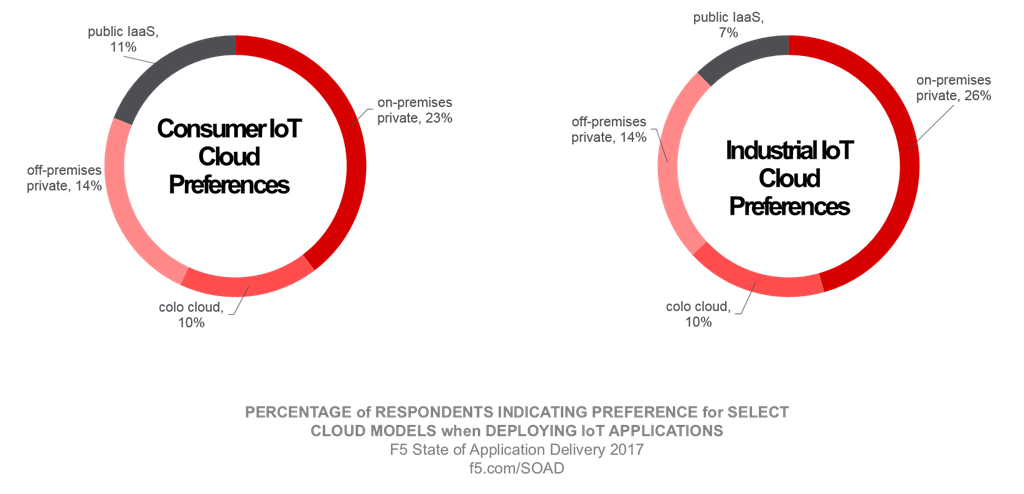モノのインターネットとクラウドが交わる場所
アプリケーション配信の現状に関する洞察 2017.
モノのインターネットが、その日のテクノロジーの寵児として他のあらゆるトレンドを凌駕する途中で、興味深いことが起こりました。それは、モノのインターネットが分裂したことです。
実際には、「モノのインターネット」の傘下には非常に異なる 2 つの市場が存在します。 1 つ目は、私たち全員が知っていて、愛している(嫌っている)消費者向けガジェット市場です。 私たちは皆、何か資格を持っているが、研究結果が正しければ、資格を持つものはおそらく 7.8 個あることになる。 これらは、私たちを喜ばせ、驚かせ、困惑させる家庭用および個人用の機器です。 ホームオートメーションに関連しているか、個人のフィットネスに関連しているかにかかわらず、消費者のモノの消費率は止まる気配がありません。
もう 1 つの市場は、それほど魅力的ではなく、あまり話題にもなりませんが、産業用 IoT (IIoT) です。 産業側に関連する用途や課題は消費者側のものとは大きく異なるため、この区別は重要であるだけでなく、必要です。 可用性はどちらにとっても常に懸念事項ですが、ビジネス運営と製造がモノによって生成され、1 日に何百万もの決定を実行するますますスマートなシステムによって処理されるデータにほぼ完全に依存するようになるため、可用性は産業市場で非常に重要になります。
パフォーマンスも、IIoT をサポートするシステムやアプリにとって非常に重要な特性になります。 人間の安全が、事故前に機器をシャットダウンできるほどセンサーのデータを速く受信できるかどうかに関係する場合、パフォーマンスは競争上の優位性であるだけでなく、重要な要件でもあります。
もちろん、セキュリティが最も重要になります。 IIoT ネットワークの 1 つの侵害が災害につながる可能性があります。
しかし、産業用であろうとなかろうと、あらゆる IoT イニシアチブの成功にはクラウドが不可欠な要素であることはほぼ議論の余地がありません。 パブリック IaaS クラウドは、スケールとその背後にあるコスト効率の高いコンピューティングのニーズに対する答えとしてよく称賛されています。 パブリック IaaS クラウドにより、レポート、質問への回答、更新の取得、所有者からの指示の受信が必要な数百万 (または数十億?) のものに簡単にアクセスできるようになります。

しかし、IIoT の場合、パブリック IaaS クラウドは必ずしも意味がありません。 決定を下すシステム (拡張して大量のコンピューティングを活用する必要があるシステム) は、センサーやそのシステムが相互作用する対象の近くに配置する必要があります。 それらは、敷地内に存在し、製造フロア全体に広がっていたり、倉庫内の棚に整然と並べられていたりします。 これらのシステムからデータを遠く離れたパブリック IaaS クラウドに送信するように強制すると、望ましくない遅延が発生し、センサーが監視している条件や状況に災害よりも迅速に対応するために必要なパフォーマンスが低下します。
組織は、オンプレミスとオフプレミスの両方におけるコロケーションとプライベート クラウドなど、自らが制御できるクラウド モデルを強く好んでいるようです。 パブリック IaaS はどちらの市場でもあまり成功していませんが、IIoT システムとアーキテクチャを実装する人が選択する可能性は間違いなく低くなります。
もちろん、IoT 市場の大きな部分を占めるヘルスケアが「産業用」グレードの IoT なのか、それとも「消費者用」グレードの IoT なのかなど、いくつかの疑問が残ります。 結局のところ、患者を監視し、医療スタッフに潜在的な問題を警告するために、センサー(一部はますます「ウェアラブル」化している)に依存していますが、同じくらい多くのセンサーが現場で使用され、重要なインフラを監視しています。 驚くべきことに、ヘルスケアはどちらの IoT 市場でも最大の投資を行っている業界の一つではありませんでした。 医療業界は、モバイル アプリ、プライベート クラウド、ビッグ データに同等の熱意を持って多額の支出を行っています。
当社の最新の調査では、IoT への投資は製造業 (意外ですか?)、テクノロジー、通信企業で最も高い評価を得ましたが、いずれのテクノロジーもこれらの業界でトップ 3 に入るほどではありませんでした。 すべての業界で投資対象として上位にランクされたテクノロジーは、ほぼ全員がプライベート クラウドまたはパブリック クラウドでしたが、少数の例外として SaaS、ビッグ データ、そして仮想デスクトップ インフラストラクチャ (天然資源) を好む企業が見られました。 これは実際には認識されていた戦略的影響とよく一致しており、産業用 IoT は消費者向け IoT をなんとか上回りましたが、どちらも雲の下に隠れたままでした。
IoT は全体的にまだ動き始めたばかりなので、関連するアプリが展開される場所にばらつきがあるのは驚くことではありません。 2 つの市場が成熟し、ベスト プラクティスが出現するにつれて、さまざまな種類のクラウドの引力によって、このようなアプリが展開される場所に対する制御が強化されるはずです。 IIoT は、制御可能なクラウド (プライベートおよびコロケーション)の側に完全に傾くように見えますが、消費者向け IoT は、よりコモディティ化された (パブリック) クラウド モデルへと自然に移行し始めると予測しています。 オンプレミスのプライベート クラウド モデルで開始し、成功 (成長) に応じて、スケールと維持コストの管理に必要なパブリック クラウド リソースを含むように移行または少なくとも拡張する場合もあります。
現時点では、IoT はクラウドよりもオンプレミスで導入されることが多くなっているようです。 これは、IoT よりもクラウドについて多くを語っているかもしれません。
